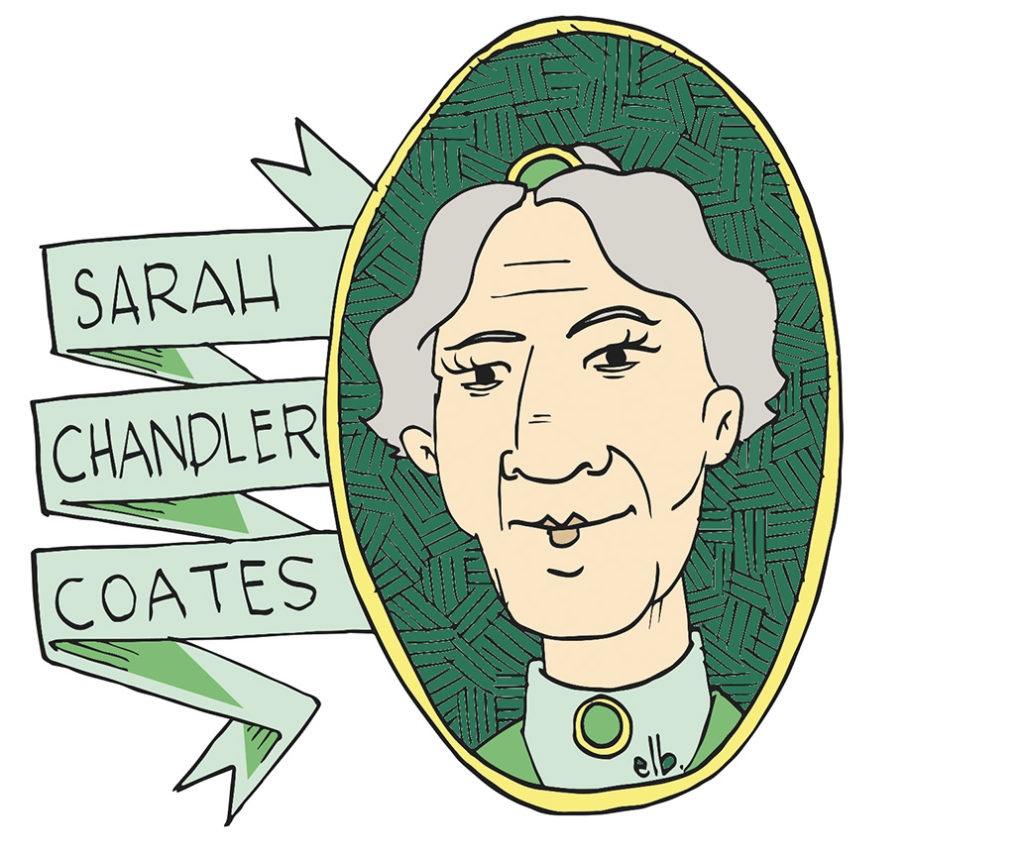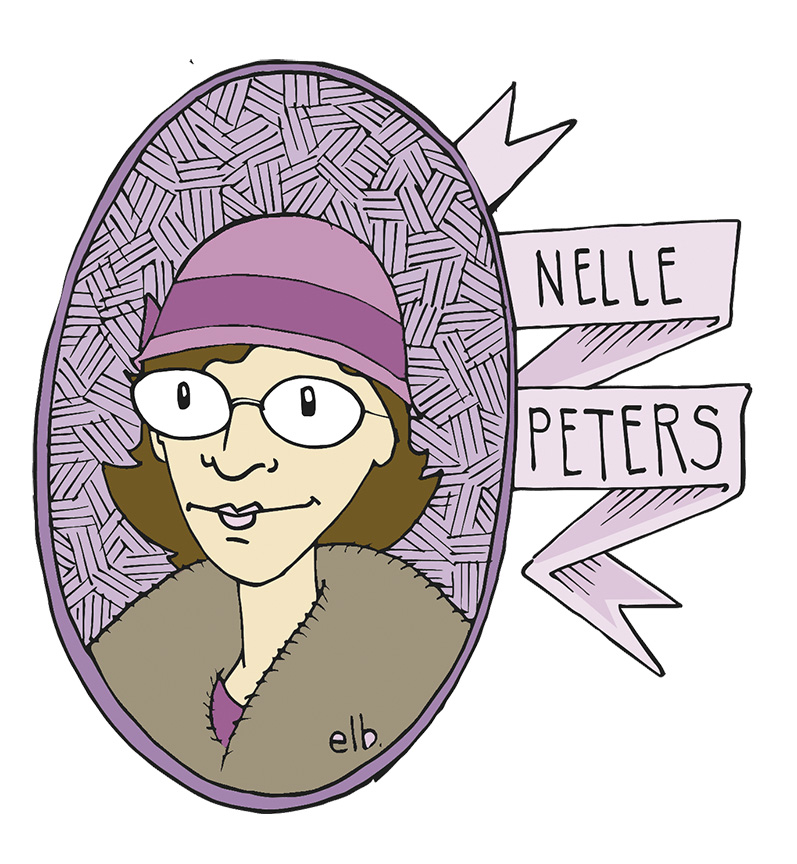
Sarah Chandler Coates came to the Town of Kansas in 1856 with her husband, Kersey Coates, who, two years earlier, purchased 110 acres of land in what is now Downtown Kansas City.
She was born March 10, 1829, to Quaker parents, in Chester County, Pennsylvania, where she met her husband Kersey, an attorney.
After moving to the Town of Kansas, her husband began working on major developments that later became Kansas City, including the bluffs at Quality Hill.
During this time, Coates was known for her charitable giving and social acts in her community.
Supporting anti-slavery organizations, Coates taught black children and adults and helped aid a Free State group that worked to prevent slavery.
She organized a women’s group to study culture and headed a local Women’s Suffrage Club.
Coates became a personal friend of Susan B. Anthony and helped found a group that became the Missouri Federation of Women’s Clubs.
“There should be no discrimination made between the sexes as regards the privilege of the ballot; I am opposed to class legislation,” Coates once stated.
In a 1898 biography compiled by her children entitled “In Memoriam”, they described her as an “abolitionist who criticized the United States flag for speaking of freedom hypocritically.”
Coates worked to advance women’s rights until her death on July 25, 1897. She is buried in Elmwood Cemetery.

Nelle Peters, one of the first major female architects in the city, is responsible for designing and creating the landscape for much of Kansas City in the early 1900s.
Born Nellie Elizabeth Nichols in 1884 in Niagara, North Dakota, she attended Buena Vista College and flourished in both mathematics and art, prompting her sister to suggest she study architecture to mesh both her talents.
Peters once told a news reporter, “When I was a child I preferred to draw mechanical things – anything from a bolt with all its threads to a steam engine.”
In a November 1925 interview with the Kansas City Journal Post, Peters recalled checking out extra geometry and algebra books from the library because she was not content with her school’s math textbooks.
She was eventually hired by Frank Colby of Eisentrout, Colby, and Pottenger in 1903, paying her $3 a week to be a drafter.
Eventually, the firm transferred Peters to its Kansas City office in 1907, but lack of work sparked her decision to start her own business.
Peters first designs included three single-family homes, which she charged $15 per design.
To not appear a novice at her craft, she labeled her first designs No. 25, No. 26, and No. 27.
In 1911, she married William H. Peters, a designer with the Kansas City Terminal Railway, but divorced him in 1923, entering into an incredibly productive phase of designing.
She began designing large apartment complexes, including one of her most well-known designs, a group of apartment buildings called the “literary block,” located on the west side of the Plaza.
The apartment buildings are named after famous authors, including Robert Louis Stevenson, Mark Twain, Eugene Field, James Russell Lowell, Robert Browning, Cezanne, and Rousseau.
Her buildings included Tudor and Spanish Colonial styles and the use of terracotta ornaments. Peters was also known for her efficient use of space in floor plans.
She designed the two Ellison Apartment buildings at 300 W. Armour, the entire block of 46th Street Terrace, and the Ambassador Hotel at 36th and Broadway, which was the largest apartment hotel at the time of its opening in 1925.
In the Northeast, Peters is responsible for the design of the two apartment buildings at 105-107, 109-111 Gladstone Boulevard (on the northeast corner of Gladstone Boulevard and St. John Avenue), which were built in 1922.
In the same 1925 interview as mentioned previously, Peters gave a glimpse into her thought process when designing.
“I work everything over and over on the floor plans,” she said. “I want each building to be as perfect, as economical and practical, as if I were building it for myself. A personal interest in work is the only thing that means anything at all—it is the only way to get anything out of it.”
In 1928, Peters designed the Luzier Cosmetics Building at 3225 E. Gillham Plaza, one of her most notable designs, and the Valentine apartment-hotel, near 36th street and Broadway.
Peters continued designing in Kansas City and even branched out to Oklahoma, Columbia, Clinton, Boonville, Jefferson City, and Ohio.
Peters remained an active architect until her retirement in 1965. She lived out her last days in a nursing home in Sedalia, Missouri, and passed away in 1974.
In her lifetime, Peters designed nearly 1,000 buildings.
The Nelle E. Peters Historic District, located on the corner of Summit Avenue and 37th Street, was dedicated in 1982 and the Nelle E. Peters Thematic Historic District was established as part of the Plaza in 1989.

Eliza “Lyda” Conley fought to protect the graves of her family and her ancestors in every way she could. She became a lawyer and argued in front of the Supreme Court a decade before women achieved the right to vote. Conley, along with her two sisters, even took a more hands-on approach to stop encroachment onto her ancestors’ graves by arming themselves with shot guns and building a shack that they called Fort Conley in the middle of the Huron Indian Cemetery.
Prior to 1843, the Wyandot Nation existed in Ohio, despite the 1830 Indian Removal Act signed by President Andrew Jackson.
A decade after the 1830 Indian Removal Act and after the Wyandot had mostly integrated with the white settlers of Ohio, the federal government finally pushed them out.
The Wyandots were promised land in what is now Wyandotte County, Kansas. However, two decades later in 1867, another treaty was signed, and the Wyandot Nation was forced to leave for Oklahoma. This treaty guaranteed the protection of the Huron Indian Cemetery. The cemetery was the resting place for hundreds of Wyandot Natives.
Conley was born either in 1868 or 1869. Her father was a British farmer and her mother was part Wyandot. When she was around the age of 11, Conley’s mother and younger sister died. A few years later, her father and grandmother died. Conley and her two sisters Ida and Helena raised themselves and put themselves through school.
All of Conley’s family was buried in a cemetery she would later fight to protect.
As the City of Kansas City, Kansas started to establish itself, the Wyandot Cemetery became a prime target for real estate. To fight back against those trying to build on top of her family’s graves, she decided to attend Kansas City School of Law. She graduated in 1902.
In 1906 both the United States government and the Wyandot tribe in Oklahoma were trying to sell the cemetery.
This is when the Conley sisters armed themselves and created “Fort Conley.” They locked the gates, put up a No Trespassing sign, and protected the land year-round.
Conley went to court to try to fight to protect the land. She tried to invoke the Treaty of 1855 that originally protected the land.
Conley, despite having Wyandot heritage was not legally recognized as a part of the Wyandot Tribe. In the Treaty of 1855, it stated that those that decided to not relocate to Oklahoma would lose their tribal rights. Since she was not legally a part of the Wyandot Nation, the court ruled against her.
Conley continued appealing her case until she progressed to the Supreme Court in 1910. The Supreme Court upheld the lower court’s decision and Conley lost.
She and her sisters continued their armed resistance, which caught the attention of the media and a Kansas senator with Kaw heritage, Charles Curtis. In 1913 he wrote and passed a bill that protected the cemetery from future development.
Conley was murdered in a robbery in 1946. She is buried next to her sisters in the cemetery they had fought hard to protect.
There have been several attempts to develop the land since that 1913 law, but in 2017 the cemetery was finally designated a National Historic Landmark.

Dr. Alice Berry Graham was born in 1852 and her sister, Dr. Katharine Berry Richardson, was born in 1860. The two sisters founded Children’s Mercy Hospital in Kansas City in 1904.
Born in Kentucky, the sisters both completed high school, which was out of the norm for most people, especially women, in this time period.
Graham became a teacher and used her teaching salary to support her younger sister as she went to college. Richardson earned a bachelor’s and master’s in philosophy and then earned an M.D. from Pennsylvania Women’s College of Philadelphia.
Richardson then began working as a teacher so she could support Graham as she attended Philadelphia Dental College.
The sisters moved to Kansas City in 1897 and attempted to open a medical practice. They struggled to find clients because few people trusted women doctors during this time period. They also struggled to get hired onto the staff at the local hospitals.
In 1897, Graham found a young sick girl whose mother could no longer pay for her care. Graham and Richardson rented a bed and supplies from the Hospital for Women and Children that was located at 15th Street and Cleveland Avenue. They worked to save this girl, free of charge to the mother.
They continued caring for children at no charge using money that had been donated to them. They eventually bought the maternity hospital after it went bankrupt in 1899, naming it the “Free Bed Fund Association for Crippled, Deformed, and Ruptured Children.”
In 1904 they renamed it “Children’s Mercy Hospital” and provided free care to children whose family could not afford their care.
Graham died in 1913 and Richardson died in 1933, but their legacy in Children’s Mercy Hospital lives on over a century later.
Children’s Mercy Hospital has moved several times since its founding. In 1917 the construction of a $375,000 ($7.5 million in today’s dollars) hospital was finished at 1710 Independence Avenue in the
Historic Northeast. 1710 Independence Avenue is now the home of the Kansas City University Administration Building.
The main Children’s Mercy Hospital campus is now at 2401 Gillham Road in Kansas City.
According to the Children’s Mercy Hospital KC website, “Children’s Mercy is a leading independent children’s health organization dedicated to holistic care, translational research, breakthrough innovation, and educating the next generation of caregivers. Together, we transform the health, well-being, and potential of children, with unwavering compassion for those most vulnerable.”



















